Archaeology, Ethnology & Anthropology of Eurasia @journal-aeae-en
Статьи журнала - Archaeology, Ethnology & Anthropology of Eurasia
Все статьи: 524
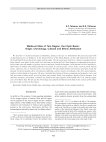
Medieval sites of Tara region, the Irtysh basin: origin, chronology, cultural and ethnic attribution
Статья
Бесплатно
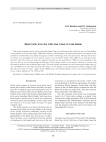
Metal Celts from the Little Sea Coast of Lake Baikal
Статья научная
This article examines metal celts accidentally found 2 km west of Kurma on the Little Sea coast of Lake Baikal, in the foothills of Primorsky Ridge, Olkhonsky District, Irkutsk Region. Detailed information is provided on the conditions in which they were found and aspects of their technology, form, and decoration. The specimens have no eyelets, are rectangular in cross-section, and were cast in bivalve molds. They differ in size and decoration. On their wide sides, there are holes for supports inserted into the mold halves. While no exact parallels to the celts are known, several chronological indicators (body shape, socket cross-section, absence of eyelets, and decoration) point to the Scythian-Tagar stage. The most similar specimens are the Krasnoyarsk-Angara type of celt, distributed over the taiga belt from the Yenisei to the Angara. X-ray spectrometric analysis suggests that the celts were made of “pure” copper. In the Olkhon area, the Scythian-Tagar celts are associated with the Slab Grave culture, dating to 2778–1998 cal BP.
Бесплатно
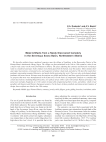
Metal artifacts from a newly discovered cemetery in the Severnaya Sosva basin, Northwestern Siberia
Статья обзорная
Бесплатно
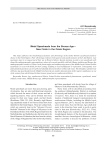
Metal spearheads from the Bronze Age – new finds in the Omsk region
Статья научная
This study addresses the morphological features and chronology of the Seima-Turbino spearheads found by chance in the Omsk Region. Their chronology evidences both general and specific features of their distribution. Late specimens attest to a long period of their use in Western Siberia. Special attention is paid to rare spearheads with Janus-like anthropomorphic representations, whose style reveals parallels with both Okunev tradition and Bronze Age anthropomorphic toreutics of China. In the forest-steppe and southern taiga areas of the Middle Irtysh, Seima-Turbino spearheads co-occur with molds for their casting, testifying to local manufacture or replication. Consequently, even undocumented specimens can reveal the meridionally directed (south to north) trade routes. The abundance and diversity of Bronze Age spearheads from the Middle Irtysh provide yet another demonstration of this region's significance as one of the centers from which Seima-Turbino bronzes spread across southwestern Siberia.
Бесплатно
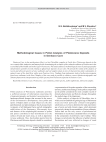
Methodological issues in pollen analysis of Pleistocene deposits in Denisova Cave
Статья научная
Denisova Cave, in the northwestern Altai, is a key Paleolithic complex in North Asia. Pleistocene deposits in the cave contain lithic industries and human fossils documenting the evolution of the cultural traditions of Denisovans in the second half of the Middle and in the Upper Pleistocene. This study addresses methodological issues in paleogeographic interpretation of pollen records relating to Quaternary deposits of cave sites. We present the results of the analysis of recent and subrecent spectra of cave sediments and soil samples taken at sites of characteristic plant communities in natural zones of the Anui River valley near Denisova Cave. Findin gs from taphonomic study of pollen microremains from loose sediments in the East Chamber of the cave make it possible to obtain a correct climato-stratigraphic and climato-phytocenotic interpretation of pollen spectra from Pleistocene deposits in Denisova Cave.
Бесплатно
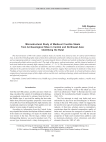
Статья научная
The microstructure of 9th–15th century artifacts made of crucible steel, found at sites in Central and Northwest Asia, is described. Metallographic study of items from settlements and burials with precise data on chronology, location, and accompanying artifacts is important for reconstructing the history of bulat steel and the technology of melting and processing ultra-high-carbon crucible steel. The study of the macro- and microstructure, and the chemical analysis of such items indicate an extremely high content of carbon—1.7–2.1 %. The characteristic feature of their microstructure is a dark matrix with white inclusions of ledeburite and iron carbides. The combination of structural components is reflected in the patterned structure of the metal. These properties suggest that such metal is identical to bulat steel. Findings of macrostructural analysis extend our knowledge of the varieties of this metal, its structural features, phase composition of separate groups of ultra-high-carbon crucible steel, smelting technology, plastic and thermal treatment, and physical properties.
Бесплатно
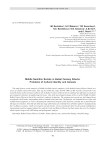
Middle Neolithic burials in Baikal-Yenisey Siberia: problems of cultural identity and genesis
Статья научная
The study focuses on the analysis of Middle Neolithic burial complexes of the Baikal-Yenisey Siberia. Based on a series of reliable radiocarbon dates, their age lies within the range of 6190–5900 cal BP. It partly corresponds to the end of the hiatus in the mortuary traditions of Cis-Baikal. Features of the burial rite and funerary offerings are analyzed and compared with those of neighboring territories. One of the most frequent images in the art of the Middle Neolithic Baikal-Yenisey Siberia is that of the waterfowl, rendered as fi gurines. The common grave goods are leaf-shaped stone arrowheads, shell beads, and pendants made of animal bones and teeth. The funerary rite included the use of fi re and reddish mineral pigment, as well as disrupting the anatomical integrity of the skeletons, possibly due to partial burial (the data are tentative). Most burials of the late stage of the hiatus are evidently those of hunter-gatherers manufacturing the Ust-Belaya ceramics, which were found in certain burials. A bone arrowhead with a biconical point and fi gurines representing waterfowl suggest cultural ties with the Urals and Western Siberia; but their nature has yet to be clarifi ed, which requires large-scale AMS-dating and paleogenetic analysis.
Бесплатно
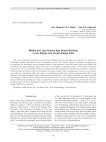
Middle and Late Bronze Age house-building in the steppe and forest-steppe Altai
Статья обзорная
Бесплатно
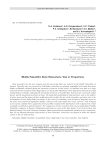
Middle paleolithic bone retouchers: size or proportions
Статья
Bone retouchers are the most common tools for processing lithic raw material in the Middle Paleolithic of Eurasia. Typically, they are perceived by Paleolithic researchers as informal, unmodifi ed tools made from bone blanks accidentally obtained during the extraction of marrow. In this article, we introduce new data on a large collection of bone retouchers from Chagyrskaya Cave (in the Altai Mountains). Their dimensions demonstrate a high standardization of blanks, indicating the intentional selectivity of Neanderthals. Selection also concerned animal species and the anatomical positions of bones. We found that morphological characteristics such as the number of active areas and the degree of their modifi cation did not affect the size of the retouchers and attest only to the reorientation of tools during lithic processing. In the course of retouching, cross-sections of diagnostic traces in the active areas underwent signifi cant changes: whereas at the early stages they reveal “furrows” with V-shaped cross-sections, multiple blows against the processed lithic resulted in the deformation of the original form, which eventually resembled an upturned trapeze. The comparison of bone retouchers from several multicultural Middle Paleolithic complexes in Eurasia (Chagyrskaya and Denisova caves in the Altai, Kabazi V site in the Crimea, and Barakayevskaya Cave in the Caucasus) evidences similar proportions but considerable variation in size. Proportions, then, are an inherent functional characteristic of bone retouchers, which does not depend on either the cultural context or the raw material base.
Бесплатно
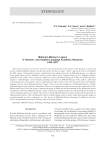
Miklouho-Maclay's legacy in Russian and English-language academic research, 1992-2017
Статья обзорная
Бесплатно
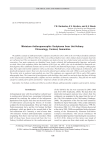
Miniature anthropomorphic sculptures from Ust-Voikary: chronology, context, semantics
Статья научная
We publish a sample of anthropomorphic sculptures unearthed in 2012–2016 at the Ust-Voikary fortified settlement in the circumpolar zone of Western Siberia. This is one of the permafrost sites, where artifacts made of organic materials are well preserved. The vast majority of the sculptures are made of wood, two of sheet metal, and one from a limonite concretion. Four main categories are identified: busts, heads, relatively full anthropomorphic figurines, and masks on sticks. Most of the sculptures follow the tradition of Ob-Ugric art, while a few can be attributed to Samoyedic art. Some figurines have additional elements such as rows of notches and diamond-shaped signs. According to ethnographic data, these signs endowed the sculptures with a sacral status. The finds have a clear archaeological, architectural, and dendrochronological context. Most were discovered in cultural layers dating to the early 1500s to early and mid-1700s. The artistic style is analyzed, and parallels are cited. The sculptures are compared with 18th to early 20th century ethnographic data. The connection of most figurines with dwellings, their small size and style show that they all belong to the ritual wooden anthropomorphic sculpture and were attributes of domestic sanctuaries. They fall into two main categories: family patron spirits and ittarma—temporary abodes of souls of the dead.
Бесплатно
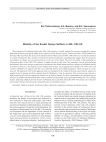
Mobility of the Suzdal Opolye settlers in 900-1150 AD
Статья
The formation of Northeastern Rus in the 10th–11th centuries is usually regarded as a process triggered by intense multicultural interaction and the infl ux of new settlers from the Dnieper region, Northwestern Rus, and Scandinavia to the Volga-Oka watershed. The dense rural settlement network that existed in 1000–1300, which was recently documented in central Northeastern Rus, and the reconstructed medieval landscapes unambiguously suggest that the prosperity and stability of villages was an important factor in the rise of the region. The level of mobility of the population in Northeastern Rus in the 10th–12th centuries is highly relevant to this issue. This parameter can be assessed using paleodietary data on the isotopic composition of strontium in the dental enamel and bone collagen of individuals buried at medieval cemeteries. The analysis of such samples from a large, rural agglomeration dating to the 10th–early 13th centuries, Shekshovo-9, suggests that this was a culturally diverse and wealthy population, which was part of a trade network. The migration level in this agglomeration was estimated by the results of the mass spectrometric analysis of samples from 24 humans and three animals from the Shekshovo-2 and -9 cemeteries. The reconstructions indicate a high proportion of locals as compared to similar sites in Eastern Europe. No direct relationship was found between the presence of artifacts introduced from other cultures and the isotopic profi le of fi rst-generation immigrants. The resulting pattern, indicating a high proportion of native individuals, has no parallels among the 10th–11th century sites in Eastern and Northern Europe represented by comparable data on strontium isotopes.
Бесплатно

Modeling the deformation of bone points: archaeological and experimental data
Статья обзорная
Бесплатно

Mongol warriors of the Jochi ulus at the Karasuyr cemetery, Ulytau, Central Kazakhstan
Статья обзорная
Бесплатно

Статья научная
This article presents the results of a comprehensive study of two unusual large wooden statues with anthropomorphic faces. They were excavated from the Ust-Voikary stratified site, in the southwestern Yamalo-Nenets Autonomous Okrug. The site dwellers were native Siberians (Ugro-Samoyeds), who lived there from the Middle Ages to the recent centuries. This is one of the few sites in the region with frozen habitation deposits. The statues are unique in terms of attribution, size, preservation, and integrity of archaeological context. They were part of dwellings, being situated in the foundations of the walls near the entrance. Their faces are modeled in bas-relief. Iconographically, they conform to the Ob Ugrian sculptural tradition. The analysis of the architectural context of the location of the statues and certain details suggests a secondary use. Initially, they might have belonged to the frame supporting the roof. The statues are made of Siberian larch (Larix sibirica Ledeb.). The dendrochronological analysis has allowed us to estimate the date when the trees were felled—the late 17th century. A retrospective analysis of data on the ritual art of the northern Khanty and Mansi suggests an interpretation of the Voikary statues in comparing them with wooden sculptures representing menkvs—forest spirits. Thus, their ritual role was mostly to protect the home.
Бесплатно






